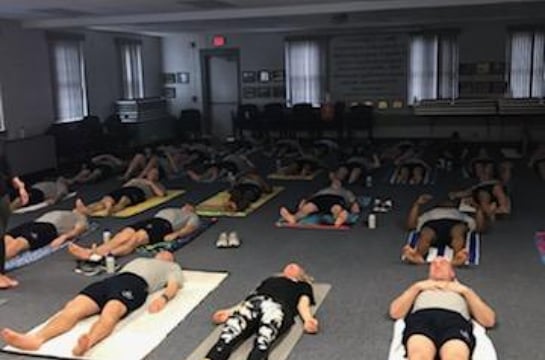It is estimated that police officers will be exposed to more than 900 potentially traumatic incidents during their career, both direct and vicarious. Officers also experience organizational stress that, in combination with operational stress, may be detrimental to health and well-being.1 This creates a heightened risk for physical and psychological disease. As a result, it is estimated that 12–35 percent of actively serving police officers may meet the diagnostic criteria for post-traumatic stress injury (PTSI) at any given point but go undiagnosed.2
Figure 1: Risks of High Stress |
|
| PHYSICAL | PSYCHOLOGICAL |
| Cardiovascular diseases/Palpitations | Anger, fear, despair, irritability, tension |
| High blood pressure | Burnout |
| Diabetes | Anxiety |
| Gastrointestinal issues | Long-lasting depression |
| Adrenal/Cortisol dysregulation | Disrupted sleep |
| Neurological injury/Brain fog | Nightmares |
| Cancer | PTSI symptoms |
One of the physical health risks police officers are suffering from is metabolic syndrome—a set of risk factors for chronic diseases—due to the high levels of stress. The syndrome involves high blood pressure, obesity, diabetes, and high cholesterol. If someone has high readings for three of the four areas, they are considered to have metabolic syndrome.
In policing, shift work can take a toll on employees’ minds and bodies. Research shows that circadian misalignment caused by shift work increases blood pressure, inflammatory markers, gastrointestinal disease, and cardiovascular disease risk.3 Humans possess an endogenous circadian system that optimally synchronizes physiology and behavior to the sunlight. This 24-hour body clock is connected to a person’s brain, as well as all peripheral tissues and organs, and intrinsically operates at the molecular level.4 The timing of sleep cycles and many other hormonal and detoxification processes are hardwired by the presence or absence of light. Disruptions in one’s natural circadian rhythm can affect their sleep, mood, level of stress hormones, metabolism, gut microbiome, and blood sugar levels. Imbalances in the body can lower a person’s energy reserves, contribute to burnout, and negatively affect their ability to cope with stress and trauma.
 In 2007, the International Agency for Research on Cancer, part of the World Health Organization, classified shift work with circadian disruption as a probable human carcinogen.5 Night shift workers and police employees who are affected by night shift patterns (e.g., those who get up at 4:00 a.m. for a 6:00 a.m. shift) are more likely to experience metabolic syndrome and are at a greater risk for becoming overweight due to poor diet and disruption in their circadian rhythm. The good news is metabolic syndrome can be controlled, largely with changes to one’s lifestyle. Certain lifestyle choices can optimize the body’s relaxation response, counteract the stress response, and result in physiological changes, leading to better health.
In 2007, the International Agency for Research on Cancer, part of the World Health Organization, classified shift work with circadian disruption as a probable human carcinogen.5 Night shift workers and police employees who are affected by night shift patterns (e.g., those who get up at 4:00 a.m. for a 6:00 a.m. shift) are more likely to experience metabolic syndrome and are at a greater risk for becoming overweight due to poor diet and disruption in their circadian rhythm. The good news is metabolic syndrome can be controlled, largely with changes to one’s lifestyle. Certain lifestyle choices can optimize the body’s relaxation response, counteract the stress response, and result in physiological changes, leading to better health.
If some of these diseases or conditions could be identified before becoming critical, they could be controlled or possibly prevented and reversed. Investing in proactive approaches to officer well-being, such as proper education and practice, is a foundational factor in high-performing workforces and can have positive long-term returns on investment for the agency, including reductions in health care costs and claims, increases in productivity, better employee health and safety, lower rates of absenteeism, higher rates of retention, and positive organizational culture. Training on trauma-informed care and the nature of police work from a health care perspective can help officers better understand the impact of trauma on themselves and how to interact with other members who have experienced it.
Promising Research
A 26-week study on 157 Royal Canadian Mounted Police cadets (79 percent male) in 2023 was published on the Canadian Institute for Public Safety Research and Treatment (CIPSRT) website. It was designed to examine differences in cardioautonomic lability by comparing participants who did and did not screen positive for one or more mental health disorders at the start of training. Cardioautonomic lability refers to changes and fluctuations in the nervous system and how nervous system changes influence cardiovascular functions, such as heart function and blood circulation.6 Electrocardiogram (ECG) signals integrated into Hexoskin garments were used to record ECG and heart rate results. Researchers found cadets who reported clinically significant anxiety symptoms showed less heart rate variability (HRV) along the Low Frequency (LF) to High Frequency (HF) ratio.
HRV is a measure of the health of the nervous system. According to the researchers,
The relatively lower [heart rate] variability suggests decreased parasympathetic tone in those without anxiety symptoms. Parasympathetic tone is responsible for regulating involuntary bodily functions related to relaxation and recovery – such as heart rate and steady breath.7
Figure 2: HRV Impacts |
| Lower HRV: When stressed, people move into fight-flight-freeze quicker and it takes longer to recover from a stressful event, including eliminating cortisol levels from one’s system. |
| Higher HRV: The nervous system has more flexibility and adaptability to stressful incidents and can return to baseline more efficiently. |
The study was designed to provide baseline measures for future analyses as part of their longitudinal study of members over the course of their careers. The current results may have important implications for future research on cardioautonomic dysfunction and chronic adrenal dysfunction, two indicators related to anxiety and the excessive activation of the fight-or-flight nervous system response from stress exposures. This study is significant for observing potential differences and changes in cardioautonomic lability, which can assist in developing tools to identify physiological characteristics or precursors to PTSI.
Following periods of chronic or traumatic stress, the human nervous system thinks this “danger” zone is the body’s normal state, thus losing the zone where rest, rejuvenation, repair, and digestion happen. Stress and trauma are not just psychological—they’re physiological —and they profoundly influence all of the body’s systems (immune, blood pressure, respiration, endocrine, digestive, etc.).
CIPSRT advised the results help to continue advancing Canada’s first-ever National Action Plan on Post-Traumatic Stress Injuries.
In April 2019, Canada’s Minister of Public Safety and Emergency Preparedness, in partnership with the Minister of Health, released a document titled Supporting Canada’s Public Safety Personnel: An Action Plan on Post-Traumatic Stress Injuries. Under Section 3.0—”A Coordinated Action Plan”—it states,
The Government of Canada recognizes the urgency for immediate action…. However, at present there has been insufficient research that can soundly recommend which treatments or interventions effectively work for public safety personnel, and those which do not.8
Three areas of focus were identified:
-
- Investing in research and data collection
- Advancing efforts in prevention, early intervention, and stigma reduction
- Supporting care and treatment
Interrelated and complementary, these areas of action collectively undertaken will provide a foundation for supporting public safety personnel.9
A Global Outlook
As the saying goes, a local problem is a global problem. This is not unique to Canada. At the international level, police organizations are faced with the same challenges: resource shortages; staff retention; budget restrictions; limited research availability and methods of integrating well-being, evidence-based program development; and increasing insurance claims. Research has largely been focused on negative symptoms to traumatic incidents rather than aspects of promoting mental and physical well-being—there needs to be a focus on growth, development, and healing. Managing trauma in police officers can be a challenging task. The nature of their work exposes them to high levels of stress, violence, and trauma, which can lead to operational stress injuries such as clinically diagnosed depression, anxiety, and post-traumatic stress disorder (PTSD). A knowledge gap still exists for many police agencies in having wellness units, programs, supports, or training and bridging current academic research to the practical field.
A Culture Toward Preventative Health

Recognizing one size does not fit all, police wellness approaches need to address the broad mental health spectrum. The scope of mental health programs needs to be expansive and to continuously grow to ensure employees get the support they need. As new research emerges, wellness programs must continue to innovate and adapt to effectively build resilience. There is a lot of talk about police mental health and resiliency, yet many officers still don’t have the tangible tools necessary for daily preventative maintenance or for developing individual well-being protective factors. Police departments must be willing to make transformational culture change toward well-being and broadening their supports.
Dr. Norman Farb, associate professor and researcher for the Department of Psychology, University of Toronto, has been studying the neuroscience of human identity and emotion, with a focus on how cognitive biases shape emotional reactions determining well-being. For example, some people seem to shrug off stressful encounters, whereas others cannot let them go. His research focuses on social and affective neuroscience, mindfulness, emotions, interoception, self-reference, sense-forging, and regulation through functional magnetic resonance imaging (MRI). What’s particularly interesting about the research is his focus on how cognitive training practices such as mindfulness meditation may foster resilience against stress, reducing vulnerability to affective disorders such as depression.

In one of Dr. Farb’s research papers, interoception was studied with the goal of presenting a unified perspective from diverse fields such as neuroscience, clinical practice, and contemplative studies. Interoception is the process of receiving, accessing, and appraising internal bodily signals. This can be conscious and subconscious.10
Many body-based contemplative practices such as mindfulness, meditation, breathing techniques, and yoga involve explicit direction of attention to interoceptive sensations. The study advised greater accuracy of interoceptive self-representation promotes greater moment-by-moment adaptation, whereas dissociation from accurate representation can lead to dysregulation. Accordingly, many contemporary health problems involve dysregulated interoceptive processes, including affective disorders, addiction, eating disorders, chronic pain, dissociative disorders, PTSD, and somatoform disorders.11
The mind is constantly surveying the environment and body to compare to past experiences to interpret a person’s present experience, which creates a feedback loop in their conscious experience. Due to the nature of police work, many individuals become primed for hypervigilance. Trauma carries conditioned memories; by discovering one’s own conditioning and noticing one’s breath through interoception, an individual can develop the skill to notice when their physiology is dysregulated.
Relevance to Policing
Interoception is one of the important practices to help individuals come back into their window of tolerance. The window of tolerance, developed by Dan Siegel, a clinical professor of psychiatry, is the zone where intense emotional arousal or stimulation can be processed in a healthy way, allowing an individual to function and react to stress and anxiety effectively. Repeated trauma and stress exposures can shrink the window of tolerance causing individuals to get stuck either into a high hyper-arousal (e.g., fight or flight activation, impaired judgement, rigid thinking, racing thoughts, feeling too much, emotional reactivity, distress, hypervigilance, anxiety, panic, anger, fear) or a low hypo-arousal (e.g., feeling too little, absence of sensations, numbness, shutdown, isolations, withdrawal, depression, hopelessness, loss of interest, freeze, disassociation, detachment) or oscillate between both.12

Practicing interoception creates an integration between the brain and body, expanding the window. Building awareness around the states of one’s mind and body throughout the day can assist in knowing when and how to bring oneself back into homeostasis, which is a person’s baseline of being regulated. Through specific practical exercises and techniques, a person can help to soothe the nervous system when it becomes activated, which helps widen the window of tolerance. Many of the practices send signals from the body directly to the limbic system, which sends messages of safety to the brain. Regularly building high tolerance coping skills through the nervous system can increase a person’s resilience in handling frontline daily trauma exposures long term.
When individuals have long-term instinctive defense responses embedded within their nervous system from chronic stressors, these responses numb people’s ability to feel the full spectrum of being alive. When people cut themselves off from feeling, they become numb to both the highs and lows of life, represented as a flat line experience. Many public safety personnel over time unconsciously turn parts of their sensory functions in the brain off to cope with the daily stress and trauma as a maladaptive coping strategy. This can show up as feeling nothing in the body, which can eventually lead to an operational stress injury if left unchecked. Individuals who shut their inner senses off also shut down their ability to update their “software” (new neural pathways), and they can become stuck. Numbness is an active process, meaning it drains nervous system energy to maintain the state of being numb. This process has been referred to as parasitic tension. It takes more energy from the nervous system to repress or suppress emotions, sensations, and cognitions because feeling and sensing is the body’s natural state. What was adaptive in the moment becomes maladaptive over time.
Rewire and Repattern
Policing is widely considered to be one of the most stressful occupations. This stress is often experienced within a context of excessive anger, which decreases officer well-being and has the potential to negatively impact public well-being. One particular study, titled “Changes in Facets of Mindfulness Predict Stress and Anger Outcomes for Police Officers,” examined whether increases in facets of mindfulness accounted for reductions in these outcomes. It stated,
Anger in policing has been negatively correlated with constructive problem solving and ethical decision-making; positively related to attributing hostile intention and inclination to punish, and to punish more harshly; associated with selective attention to hostile social cues, interpretation of behavior as hostile, and the tendency to ruminate over past anger-provoking experiences; anger and stress amplifies with exposure to traumatic stress and contributes to exhaustion; and, policing culture values emotional toughness, suppression and control.13
It went on to say,
Officers often face these stressors without being prepared to manage the cognitive, affective, behavioral, and physiological consequences of chronic stress and acute trauma and often struggle to cope with stress and its consequences within a context of co-occurring anger. As a result, officers may be prone to poor coping when faced with these challenges and may employ ineffective strategies, such as avoidance and alcohol use. In turn, these poor coping strategies have been associated with increased rates of depression, post-traumatic stress disorder (PTSD) and substance use disorders.14
The study found mindfulness reduced aggression, hostile attribution, and anger. The paper also named other studies showing the efficacy of Mindfulness-Based Resilience Training (MBRT), designed to address the specific needs and culture of police, examining three facets of mindfulness—acting with awareness, nonjudgment, and nonreactivity—to significantly reduce anger, police operational stress, and police organizational stress.15 Mindfulness refers to awareness encompassing a compassionate and flexible perspective, allowing one to experience emotions, cognitions, and physical sensations in the present.
In another study with 183 police officers, mindfulness-based treatments were identified to be effective for reducing posttraumatic stress symptoms. Greater mindfulness related to accepting without judgment, describing sensations, and acting with awareness was found to be a primary factor associated with less severe PTSD intrusion, avoidance, and hyperarousal symptoms.16 Mindful observing seemed to increase symptoms, which signifies the importance of utilizing cognitive processing to have better posttraumatic growth and mental health outcomes.
Those who react directly after their observations with worry, rumination, and negative judgment are likely to experience heightened mental distress. The quality of the response to the observation may be key in achieving positive outcomes, i.e., to observe non-reactively. Research shows mindfulness-based psychotherapy is an effective treatment for resilience, increasing emotional intelligence, and achieving substantially quicker recovery after exposure to potentially traumatic incidents.17 Psychotherapy reduces the rates of diagnosable trauma-related disorders. Using a combination of treatments and practices can enhance overall health outcomes.
Resetting the Baseline
Human bodies are designed to release stress and trauma energy. Completing the instinctually demanded behaviors in the presence of the stressor is the indicator to the nervous system that it can relax again. The absence of these discharges or expressions signals that the threat has not been solved and this instinctual defense response should stay activated. These defensive states can stay activated for weeks, months, or years. Stress and trauma energy is expressed through moving, laughing, shaking, screaming (in a healthy way), crying, or other expenditures of energy that signal to the body it can release the defense system. There are several somatic tools that help create a physiological state where feeling and discharging (expression) is accessible. Many of these somatic practices only take a few seconds to a couple minutes and can be done anywhere—at one’s desk, in the cruiser, or at home.
Expression frees the nervous system of its defense systems holding it in a contracted activated state and helps it to rewire and repattern back to homeostasis. The opportunity to access these inner elevated states through breathing, feeling, and seeing creates new patterns that embed within the neurobiology, subconscious mind, and body.
Mindful Leadership
A healthy and resilient workplace requires visible, effective, and connected leadership. Psychological health and safety are embedded in the way people interact with one another daily and is part of the way decisions are made and communicated. When leaders are stressed, their anxiety can be felt across the entire organization. Leaders are increasingly faced with uncertain, complex, and ambiguous decision-making, which can keep them living in a state of constant overdrive—“Like all members of the organization, police leaders must also be willing to work on their own issues and to take the necessary steps to be healthy.”18 When leaders actively engage in mindfulness practices, they raise the psychological capital of an organization through their own hope, optimism, self-efficacy, and resilience. Leaders who practice becoming aware of their own thought processes (metacognition), being aware of what’s happening without judgment or criticism (allowing), and staying open about situations before making decisions (curiosity) will have more control over how they react and engage. Mindfulness is a skill in being fully present and fully aware; it opens space to choose—instead of just action and reaction, it enables a choice on how to respond with intention and equanimity.
By practicing mindfulness, leaders can not only manage stress but also mitigate it. Effective investment in health and well-being can save police agencies money in terms of health care spending and lost productivity due to absenteeism. Incorporating mindfulness in treatment programs shows successful outcomes regarding general stress, depression, sleep quality, emotional intelligence, chronic fatigue syndrome, and anxiety.19 Mindfulness has also been shown to reduce other physical health risks such as metabolic syndrome. The future of policing will continue to look bright so long as policymakers and practitioners maintain their collaborative efforts, implement research, stay open-minded to change, and continue to make investments in wellness innovation. 🛡
Notes:
1Brian A. Chopko, Konstantinos Papazoglou, and Robert C. Schwartz, “Mindfulness-Based Psychotherapy Approaches for First Responders: From Research to Clinical Practice,” American Journal of Psychotherapy 71, no. 2 (October 2018):55–64.
2Brian A. Chopko and Robert C. Schwartz, “The Relation Between Mindfulness and Posttraumatic Growth: A Study of First Responders to Trauma-Inducing Incidents,” Journal of Mental Health Counseling 31, no. 4 (October 2009): 363–376.
3Christopher J. Morris et al., “Circadian Misalignment Increases Cardiovascular Risk Factors in Humans,” Proceedings of the National Academy of Sciences of the United States of America 113, no. 10 (March 2016): E:1402–1411.
4Morris et al., “Circadian Misalignment Increases Cardiovascular Risk Factors in Humans.”
5Thomas C. Erren et al., “Shift work and Cancer: The Evidence and the Challenge,” Deutsches Ärzteblatt International 107, no. 38 (September 2010): 657–662.
6Taylor A. Teckchandani et al., “Cardioautonomic Lability Assessed by Heart Rate Variability Changes in Royal Canadian Mounted Police Cadets during the Cadet Training Program,” Frontiers in Psychology 14 (September 2023).
7Teckchandani et al., “Cardioautonomic Lability Assessed by Heart Rate Variability Changes in Royal Canadian Mounted Police Cadets during the Cadet Training Program”; Canadian Institute for Public Safety Research and Treatment, “Cardioautonomic Lability and Heart Rate Variability Among RCMP Cadets,” Research Summaries.
8Government of Canada, Supporting Canada’s Public Safety Personnel: An Action Plan on Post-Traumatic Stress Injuries (Ottawa, ON: Public Safety Canada, 2019).
9Government of Canada, Supporting Canada’s Public Safety Personnel.
10Norman Farb et al., “Interoception, Contemplative Practice, and Health,” Frontiers in Psychology 6 (June 2015): art. 763.
11Farb et al., “Interoception, Contemplative Practice, and Health.”
12Andreas Comninos, “Understanding Your Window of Tolerance,” Mindfulness & Clinical Psychology Solutions.
13Aaron L. Bergman, Michael S. Christopher, and Sarah Bowen, “Changes in Facets of Mindfulness Predict Stress and Anger Outcomes for Police Officers,” Mindfulness 7 (April 2016): 851–858.
14Bergman, Christopher, and Bowen, “Changes in Facets of Mindfulness Predict Stress and Anger Outcomes for Police Officers.”
15Bergman, Christopher, and Bowen, “Changes in Facets of Mindfulness Predict Stress and Anger Outcomes for Police Officers.”
16Brian A. Chopko and Robert C. Schwartz, “The Relation Between Mindfulness and Posttraumatic Stress Symptoms Among Police Officers,” Journal of Loss and Trauma 18, no. 1 (January 2012): 1–9.
17Chopko, Papazoglou, and Schwartz, “Mindfulness-Based Psychotherapy Approaches for First Responders: From Research to Clinical Practice.”
18Irwin M. Cohen, Amanda V. McCormick, and Bob Rich, “Creating a Culture of Police Officer Wellness,” Policing: A Journal of Policy and Practice 13, no. 2 (June 2019): 213–229.
19Chopko, Papazoglou, and Schwartz, “Mindfulness-Based Psychotherapy Approaches for First Responders: From Research to Clinical Practice”; Chopko and Schwartz, “The Relation Between Mindfulness and Posttraumatic Growth.”
Please cite as
Amy Boudreau, “Regulate and Reset,” Police Chief Online, May 15, 2024.



